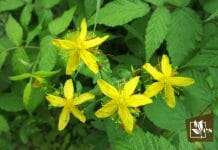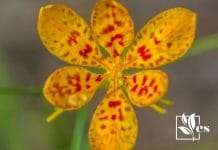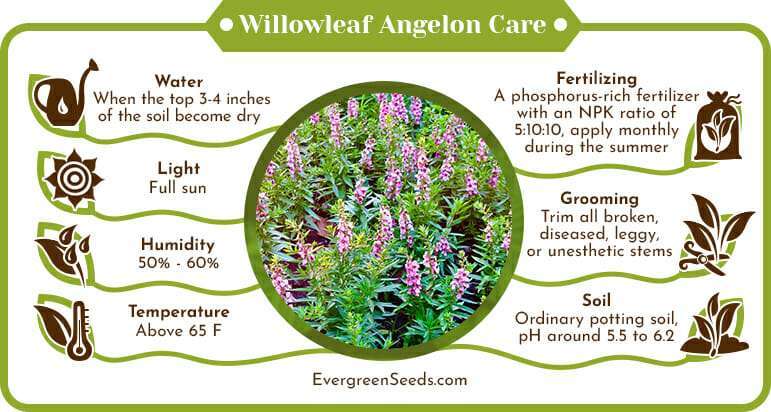 The Willowleaf angelon of the Plantaginaceae family is a very pretty plant. If you are looking for a sweet-scented plant with vibrant purple flowers, you have landed at the right place.
The Willowleaf angelon of the Plantaginaceae family is a very pretty plant. If you are looking for a sweet-scented plant with vibrant purple flowers, you have landed at the right place.
We have compiled the most comprehensive care guide to growing this salicariifolia at home. Learn some lesser-known secrets on how to water, feed and propagate this Angelonia genus plant.
JUMP TO TOPIC
What Is Willowleaf Angelon?
Willowleaf angel is a perennial species that produces purple blooms. Its flowers are variegated and double-lipped. These flowers produce an apple-like scent. They have glossy leaves, and the whole plant is covered with damp hair. This plant’s scientific name is angelonia salicariifolia.
Willowleaf Angelon Care
Here’s our guide to caring for this plant along with all its necessary conditions and requirements. Keep reading below to give your plant very happy conditions to live by:
 Light Requirements
Light Requirements
| Light Condition | Suitable | Hours of Sun | Notes |
|---|---|---|---|
| Full Sun | Yes | 6+ hrs/day | Best for growth & flowers. |
| Partial Shade | Yes | 3-6 hrs/day | Fewer flowers, leggier growth. |
| Full Shade | No | Less than 3 hrs/day | Leggy, might not flower. |
Your Angelon plant needs direct sunshine for eight hours every day. This plant not only likes direct light because this is the way that you will see the plant thriving. Shaded conditions cause its stems to become leggy, with fewer flowers and darker leaves.

If you have a well-lit outdoor space like a terrace or a yard, that is the best place to keep this plant. Ensure that nothing is blocking the light from reaching it. This could be in the form of a wall or a tall tree.
Inside the house, only a window facing towards the south receives light bright enough for this plant. Keep the pot as near this window as possible. If no south-facing window is available, you will have to buy and install artificial grow lights. You better install these lights above the plant and keep them on for 10 to 12 hours daily.
 Water Requirements
Water Requirements
| Water Frequency | Suitable | Soil Moisture | Notes |
|---|---|---|---|
| Regularly | Yes | Moist, well-draining | Ideal for consistent growth. |
| Infrequently | No | Dry to touch | Stress can cause wilting. |
| Overwatering | No | Waterlogged | Risk of root rot. |
This plant can tolerate a few days of drought pretty well because it is usually grown under full sun, we recommend you always water it on time. Wait for the first three to four inches of the soil to dry out.
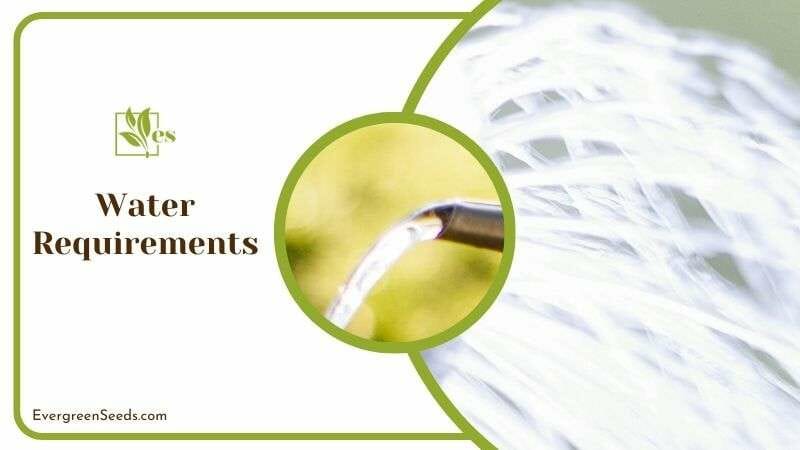
To ensure that the top inches are dry, insert a pencil into these layers. If the pencil comes back with dry soil, this means that the soil needs water. If it comes back with moist soil, you need to hold back. The willow-leaf plant does not well tolerate overwatering.
Collect tap water in a bucket the night before watering. Leave it overnight without covering it up so that all the chlorine evaporates. This makes the water so much safer compared to before. Water the soil slowly, avoiding splashing on the plant, until it starts to drain from the drainage hole.
 Soil Requirements
Soil Requirements
| Soil Type | Suitable | Soil pH | Notes |
|---|---|---|---|
| Loamy | Yes | 6.0-7.5 | Well-draining, ideal for growth. |
| Sandy | Yes | 6.0-7.5 | Good drainage, may need more nutrients. |
| Clay | No | – | Poor drainage, can stress plants. |
| Peaty | Yes | 5.5-7.0 | Rich in organic matter, retains moisture. |
This plant will grow in ordinary potting soil, given that its pH is around 5.5 to 6.2. Adding organic matter to the soil will decrease the need for frequent watering and fertilizing. You can add hummus, peat, homemade compost, or worm castings to the soil.
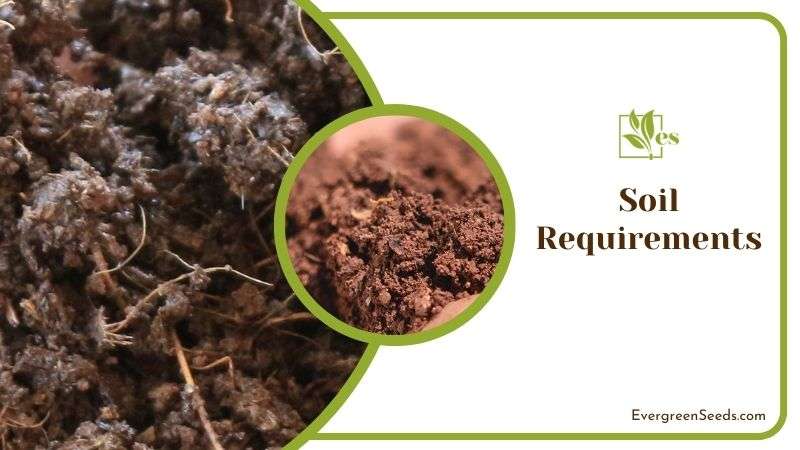
Amend your soil with perlite or vermiculite to improve its drainage. To amend a garden soil, you must till it for half a foot and add the required additive. If you are going to grow angelon in a container, then you can simply mix an ideal soil and fill the container with it.
Be smart when choosing a pot for your plant. Always buy a clay or terracotta container because these have excellent air circulation. A plastic container is an okay choice too. If you want to try a metal container, we strongly advise against it.
 Temperature Requirements
Temperature Requirements
| Temperature Range (°F) | Suitable | Duration | Notes |
|---|---|---|---|
| 75-90 | Yes | Daytime | Optimal for growth & flowering. |
| 65-75 | Yes | Daytime | Still suitable but slightly cooler. |
| 60-70 | Yes | Nighttime | Ideal nighttime range. |
| 50-60 | Maybe | Nighttime | Lower limit; risk of stress. |
| Below 50 | No | Extended | Potential damage or dormancy. |
| Above 90 | No | Extended | Can cause wilting or stress. |
On average, this plant needs more than 65 degrees Fahrenheit temperature to grow. That is why its growth stops, and the plant starts dying as soon as temperatures start dropping during winter.
If the plant is grown outdoors, it will surely die during winter. However, its roots tend to survive the frost, so the plant will grow back in the springtime. Bring your plant inside during winter If it is potted in a container pot. It will only slow down its growth. Furthermore, you will ensure it is not accidentally exposed to extremely cold air drafts.
Angelonia returns yearly if it is grown in US hardiness zones eight to 11. Only in these zones does it behave like a perennial. It freezes from the top during winters, but its roots survive the season, so the plant grows again next spring. If you choose to grow it in pots and move them indoors during winters, it will come back every year no matter which US hardiness zone they are grown in.
 Humidity Requirements
Humidity Requirements
| Humidity Level | Suitable | Range (%) | Notes |
|---|---|---|---|
| Low | Yes | 20-40% | Tolerant to drier conditions. |
| Moderate | Yes | 40-60% | Ideal for growth and flowering. |
| High | Maybe | 60-80% | Ensure good air circulation to avoid fungal issues. |
| Very High | No | 80+% | Risk of mold and fungal diseases. |
An angel on a plant grows best when air moisture levels are 60 to 70 percent. It exhibits a lack of adequate humidity by developing dry leaves that might turn brown at the edges or develop curled edges. In most areas, the average humidity is around 50 to 60 percent.
Misting the leaves lightly from a distance helps improve humidity for a short while. Depending on how dry your weather is, you might have to mist the plant twice a week. You can try a pebble tray or a humidifier if that sounds like a lot of work.
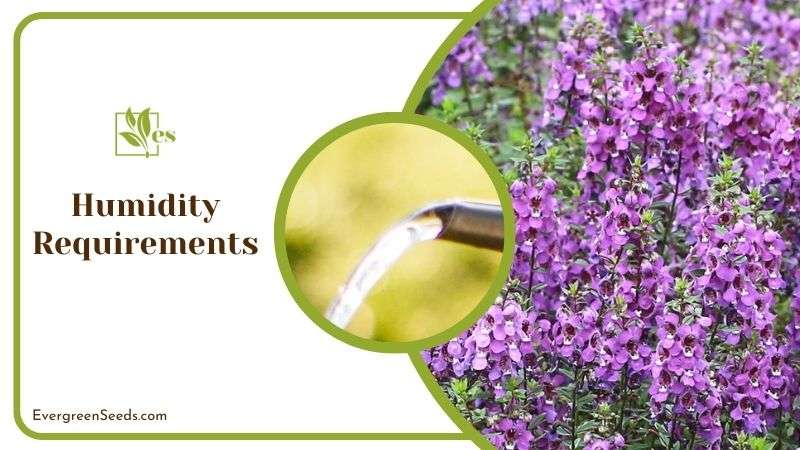
A humidifier can be costly and also uses a lot of electricity. If you have a lot of indoor plants with high humidity demands, only then will a humidifier be a feasible option. A pebble tray is the best because you only have to place it below the plant’s container and change its water once weekly. You can use tap water as well after purifying it.
 Fertilizing Requirements
Fertilizing Requirements
| Fertilizer Type | Frequency | N-P-K Ratio | Notes |
|---|---|---|---|
| General-purpose | Monthly | 14-14-14 | Balanced nutrients for steady growth. |
| High Phosphorous | Start of blooming season | 15-30-15 | Encourages flower production. |
| Slow-release | At planting | Varies | Gradual nutrient release for extended feed. |
| Organic compost | Annually | – | Enriches soil with organic matter. |
Your angelonia Serena purple plant is a light feeder. It needs only moderate fertilizing once every four weeks in summer and every two months in the winter. It is okay to stop fertilizing during winters altogether.
A liquid fertilizer releases nutrients immediately into the soil. A phosphorus-rich fertilizer with an NPK ratio of 5:10:10 leads to producing the best flower yield. NPK ratio is given on the package of all commercial feeds. Make sure you are buying from a well-reviewed and trusted manufacturer.
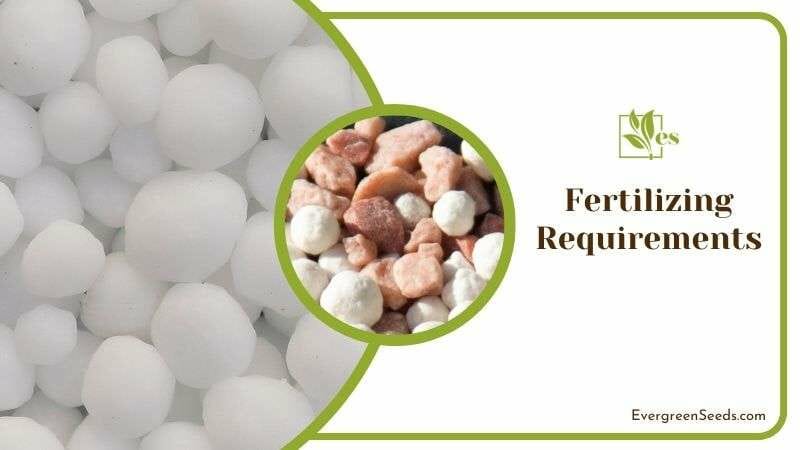
Even if the packaging says the formula is mild, you should still dilute it. Add an equal amount of water to dilute it to half its strength. Another fertilizing safety hack is to water the roots copiously during the next feeding. This would help protect the roots from getting chemical burns. Check out the 46-0-0 fertilizer and 0-0-60 fertilizer guides and pick the one that best suits your needs.
 Pruning
Pruning
You can prune this plant in the spring before the plant grows into full growth mode. You may prune it in the fall when the growth and flowering both stop because this plant has thin stems, you can pinch them off using your fingers. However, using sharp pruning shears or knives for a quicker and cleaner job would be a wise choice.
Cut off all broken, diseased, leggy, or unesthetic stems. Stems that fall to the side should also be pruned back to the base. It is not an absolute must, but you can also deadhead the flowers after a few weeks of blooming.
Propagation
To increase the population of your trailing angelonia, you can propagate it. This can be done anytime during the growing season, but it’s best to carry it out in spring. So that your plant will have sufficient root growth by the time winter arrives.
You must begin by sharpening your knife or pruning your shear properly. Then clean it with bleach or 70 percent alcohol, then wash it with water before use. The reason to do this is to stay away from any pest infestation.
You must select a stem that is not currently in bloom, a stem that’s t. Cut off three inches from its growing end. After doing so, remove all the leaves except the top one or two leaves from this cutting, because these are the ones we want to propagate, and they must be kept safe.
Apply some rooting hormone to the cut end to promote growth and prevent diseases. Initially, fill a pot with a soilless mixture to place half the cutting in. The cut part with the rooting hormone needs to go into the soil.
Remember to keep the soil moist and place the pot in a warm and bright place. Lastly, keep in mind that when the stem grows and new leaves form, you can transplant it outside if you like.
Problems
The willow leaf, also known as the serenity plant, is very low-maintenance. It might occasionally suffer from pest infestation or chronic underwatering. The pests that attack it are mostly sap-feeders.
– Pests
Like all other houseplants, this plant is also prone to attacks by sap-eating pests. These can be either mealybug, spider mites, aphids, or scale insects. They do not chew on the leaves; instead, they puncture them and feed on the sap. As a result, the plant’s health deteriorates slowly over the months.
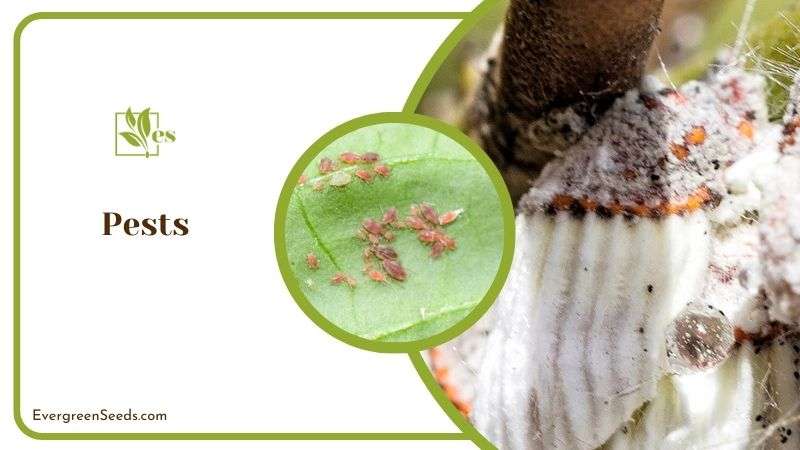
The symptoms of all these pest infestations are more or less the same. Yellow or brown spots develop on the leaves, which are covered by a sticky substance called honeydew. Honeydew attracts sooty or black mold, which turns the leaves black. Eventually, the plant starts drooping and then dropping its leaves.
Don’t worry if your plant is suffering from pests; they are easy to eliminate. All you have to do is to give it a good washing with insecticidal soap. Later, when the plant dries, apply a few drops of neem oil to the plant. You can also use a weekly neem oil foliar spray to kill the larvae.
– Underwatering
This plant can tolerate drought doesn’t mean you should neglect it for long. Take care not to let the soil more than halfway through. If it does, you will notice that leaves have started wilting.
Check the soil if your leaves are turning dry, wilted, or yellow. Insert a thin stick to the bottom to see how dry the soil is. You then need to water it right away to improve its condition.
If the soil has dried through, reverse watering is a magical cure. Place the pot in a water-filled bucket till the soil’s surface feels moist. Then take it out, and from then on, start a proper watering regime.


